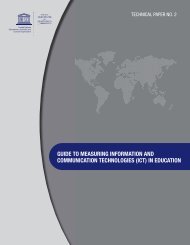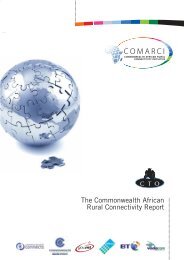ict in agriculture - Commonwealth Telecommunications Organisation
ict in agriculture - Commonwealth Telecommunications Organisation
ict in agriculture - Commonwealth Telecommunications Organisation
Create successful ePaper yourself
Turn your PDF publications into a flip-book with our unique Google optimized e-Paper software.
SECTION 1 — OVERVIEW OF ICT IN AGRICULTURE: OPPORTUNITIES, ACCESS, AND CROSS-CUTTING THEMES 29<br />
Topic Note 2.2: PUBLIC INNOVATIONS IN UNIVERSAL<br />
ACCESS TO TELECOMMUNICATIONS<br />
TRENDS AND ISSUES<br />
With technology mov<strong>in</strong>g toward fixed-mobile convergence,<br />
the provision of m<strong>in</strong>imum services (other than telephony)<br />
and public access to ICT devices has fallen with<strong>in</strong> the mandate<br />
of universal service regulations. This note exam<strong>in</strong>es<br />
the public sector’s chang<strong>in</strong>g and recently expand<strong>in</strong>g role <strong>in</strong><br />
provid<strong>in</strong>g affordable access to ICT <strong>in</strong>frastructure, appliances,<br />
and services, <strong>in</strong>clud<strong>in</strong>g the grow<strong>in</strong>g use of universal access/<br />
universal service funds.<br />
Chang<strong>in</strong>g Role of the Public Sector<br />
Public <strong>in</strong>volvement <strong>in</strong> the telecommunications sector evolved<br />
<strong>in</strong> a nonl<strong>in</strong>ear way (Gómez-Barroso and Feijóo 2010). An early<br />
monopolistic stage after the Second World War was succeeded<br />
by a series of crises <strong>in</strong> the 1970s as services came<br />
to be considered a “public matter” demand<strong>in</strong>g closer government<br />
<strong>in</strong>volvement. In the 1980s, the public sector started<br />
giv<strong>in</strong>g way to the private sector, which was considered better<br />
equipped to deliver value and efficiency.<br />
The public sector’s current role <strong>in</strong> telecommunications can be<br />
described as promot<strong>in</strong>g the <strong>in</strong>formation society. Governments<br />
act as facilitators and enablers of universal access to telecommunications,<br />
and the public sector has re-emerged as an<br />
active participant <strong>in</strong> the sector. In both developed and develop<strong>in</strong>g<br />
countries, public agencies are regarded as partners <strong>in</strong><br />
fund<strong>in</strong>g <strong>in</strong>frastructure <strong>in</strong> areas where the <strong>in</strong>centives for private<br />
<strong>in</strong>vestment are <strong>in</strong>sufficient; they are also regarded as partners<br />
by virtue of their role <strong>in</strong> encourag<strong>in</strong>g demand for telecommunications.<br />
In develop<strong>in</strong>g countries, local governments and<br />
<strong>in</strong>ternational development partners actively facilitate access<br />
to ICTs at all levels (<strong>in</strong>frastructure, appliances, and services).<br />
It is with<strong>in</strong> the doma<strong>in</strong> of local government and public adm<strong>in</strong>istration<br />
to provide <strong>in</strong>novative methods for access to ICTs<br />
<strong>in</strong> rural areas. Effective partnerships and public support are<br />
capable of overcom<strong>in</strong>g obstacles at different access layers.<br />
Until recently, the public sector was not considered an <strong>in</strong>vestor<br />
<strong>in</strong> telecommunications, but under the <strong>in</strong>creas<strong>in</strong>g pressure<br />
of the <strong>in</strong>ternational f<strong>in</strong>ancial crisis, governments have<br />
looked to ICTs as fiscally sound <strong>in</strong>vestments relative to other<br />
public stimulus options. Investments <strong>in</strong> broadband and nextgeneration<br />
networks are prov<strong>in</strong>g to work as countercyclical<br />
tools for creat<strong>in</strong>g jobs and as build<strong>in</strong>g blocks of long-term<br />
economic recovery (Qiang 2010).<br />
ECONOMIC AND SECTOR WORK<br />
Broaden<strong>in</strong>g Mandate of Universal Access/Universal<br />
Service Funds<br />
The ma<strong>in</strong> vehicles for improv<strong>in</strong>g access to ICTs <strong>in</strong> rural areas<br />
have been the univeral access/universal service funds (UA/USFs)<br />
established <strong>in</strong> the 1990s. The funds orig<strong>in</strong>ally offered an opportunity<br />
for fund<strong>in</strong>g and access to ICT solutions <strong>in</strong> underserved areas<br />
(Hudson 2010). Dedicated at first to <strong>in</strong>creas<strong>in</strong>g the penetration<br />
of landl<strong>in</strong>e telephone services, the funds now support mobile<br />
network development and Internet services <strong>in</strong> most countries. 20<br />
In some countries, such as Ghana and Mongolia, funds are<br />
disbursed to aid the provision of rural public access telephony<br />
and Internet facilities. Althoug h the expansion of mobile networks<br />
has reduced the urgency of public access to voice telephony,<br />
arguments based on gender <strong>in</strong>equality and perceptions<br />
of social obligation still favor the provision of public access<br />
(Burrell 2010). In allocat<strong>in</strong>g UA/USF funds toward services<br />
other than voice telephony, some governments specify additional<br />
criteria such as the nearby presence of public-access<br />
facilities (telecenters, libraries, Internet cafes, and so on).<br />
S<strong>in</strong>ce cost-effective technologies for the deliver<strong>in</strong>g rural<br />
access to ICTs are evolv<strong>in</strong>g constantly, it is essential that<br />
UA/USFs do not limit their technological scope and ma<strong>in</strong>ta<strong>in</strong><br />
technological neutrality. It is advisable for UA/USFs’ tender<br />
requirements to specify coverage, bandwidth, quality of service,<br />
target price, and so on—but not technology. Rural areas<br />
where the profitability of telecommunications services is low<br />
can be of limited commercial <strong>in</strong>terest to telecommunications<br />
companies. Consequently, the UA/USF levy can run the risk of<br />
becom<strong>in</strong>g a simple direct tax on the operator, and a strategic<br />
approach is needed to deliver ICT services and “unlock” the<br />
potential of UA/USFs (especially <strong>in</strong> Africa) (UNCTAD 2010).<br />
Public Support for Low-Cost Devices<br />
Unlike public support for the provision of <strong>in</strong>frastructure, public<br />
support for the provision of low-cost devices has experienced<br />
considerable criticism. The most prom<strong>in</strong>ently <strong>in</strong>stance<br />
20 The objectives of UA/USFs can be at very different stages of<br />
development and maturity. Hudson (2010) reviews key lessons<br />
related to UA/USFs’ management, professional capacity, size<br />
of fund<strong>in</strong>g, and expand<strong>in</strong>g mandate. Stern, Townsend, and Stephens<br />
(2006) recommend the accelerated, simplified, and diversified<br />
use of UA/USFs. UNCTAD (2010) discusses <strong>in</strong> detail the<br />
challenges and opportunities for f<strong>in</strong>anc<strong>in</strong>g ICTs <strong>in</strong> rural areas of<br />
develop<strong>in</strong>g countries through UA/USFs.

















